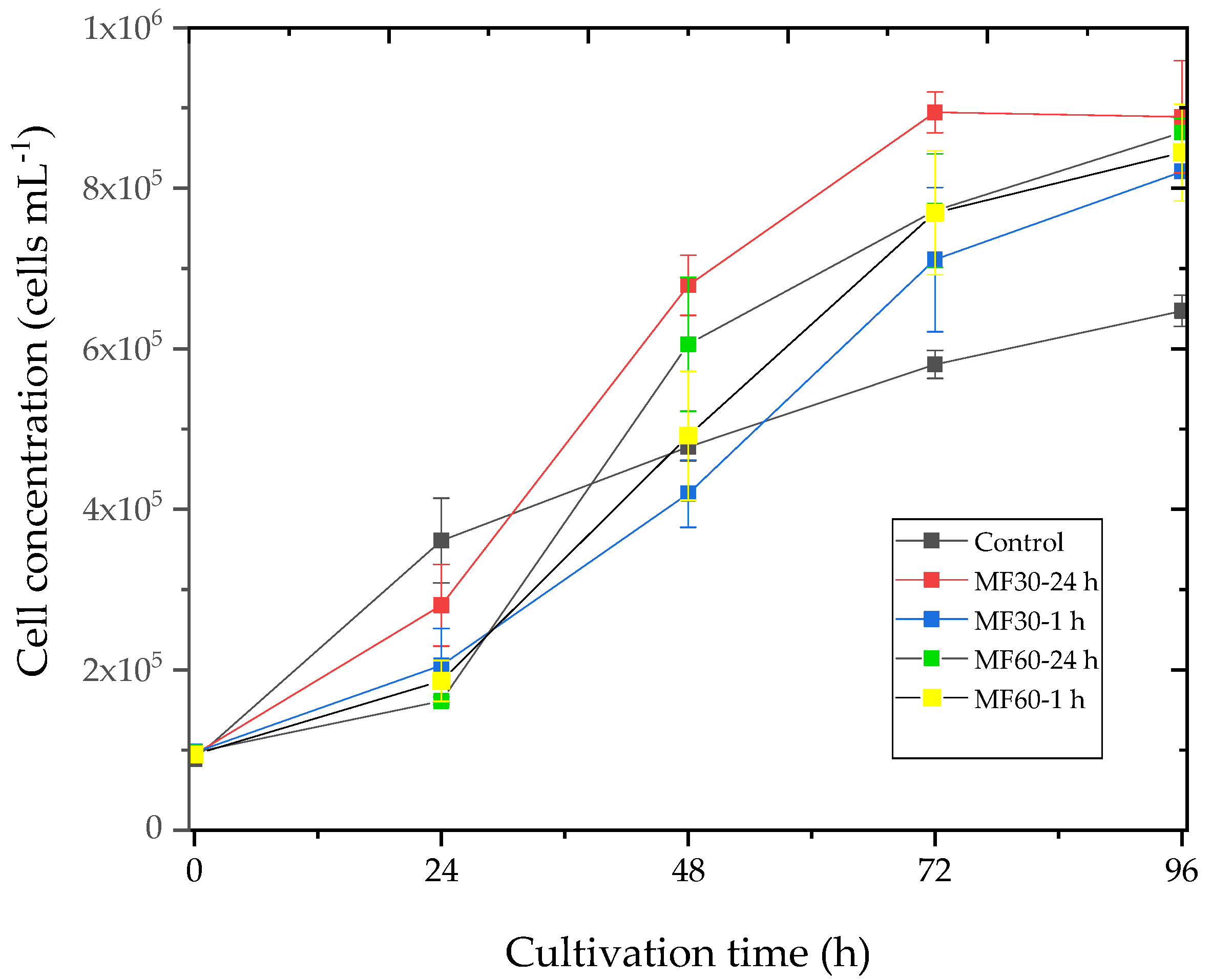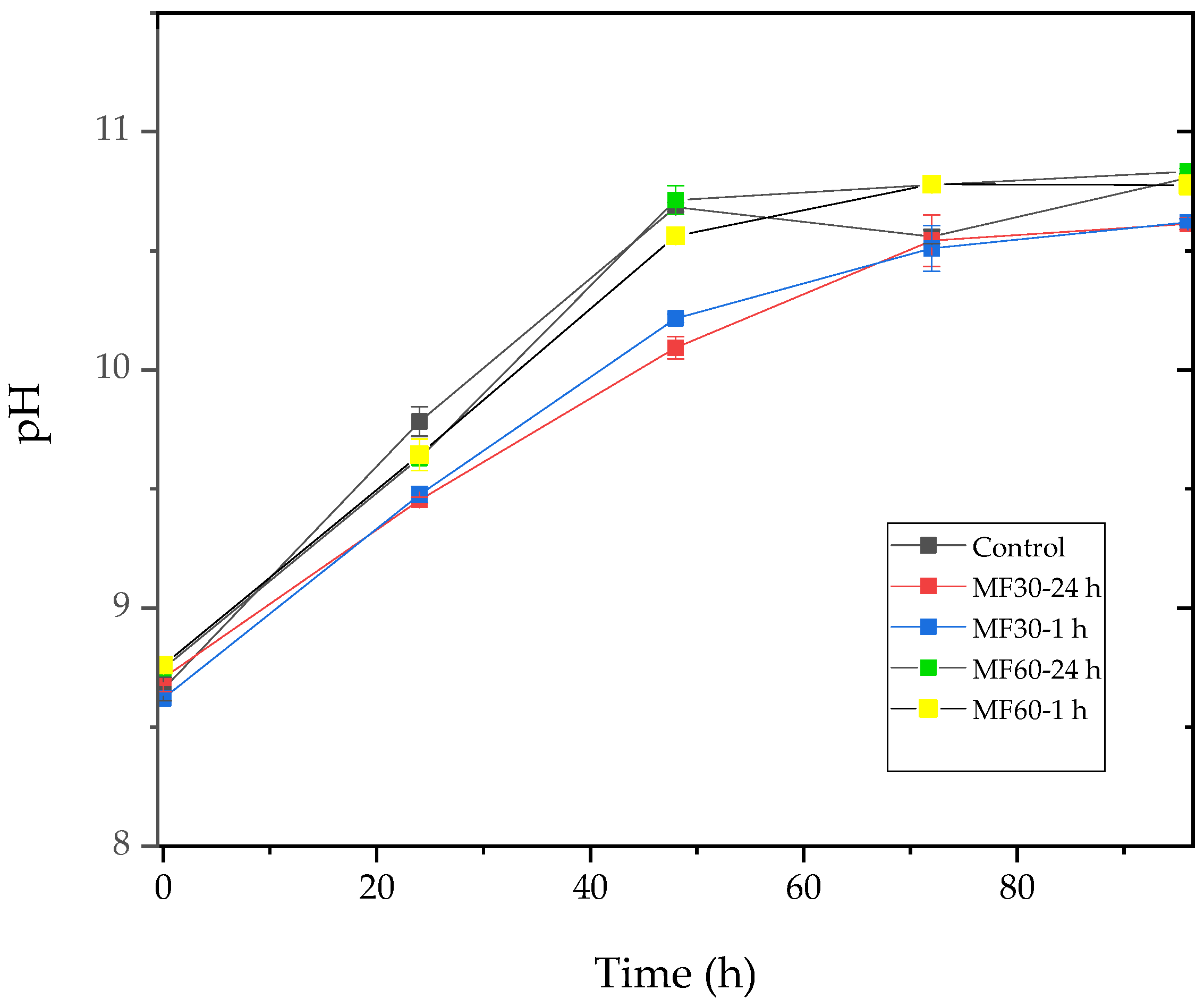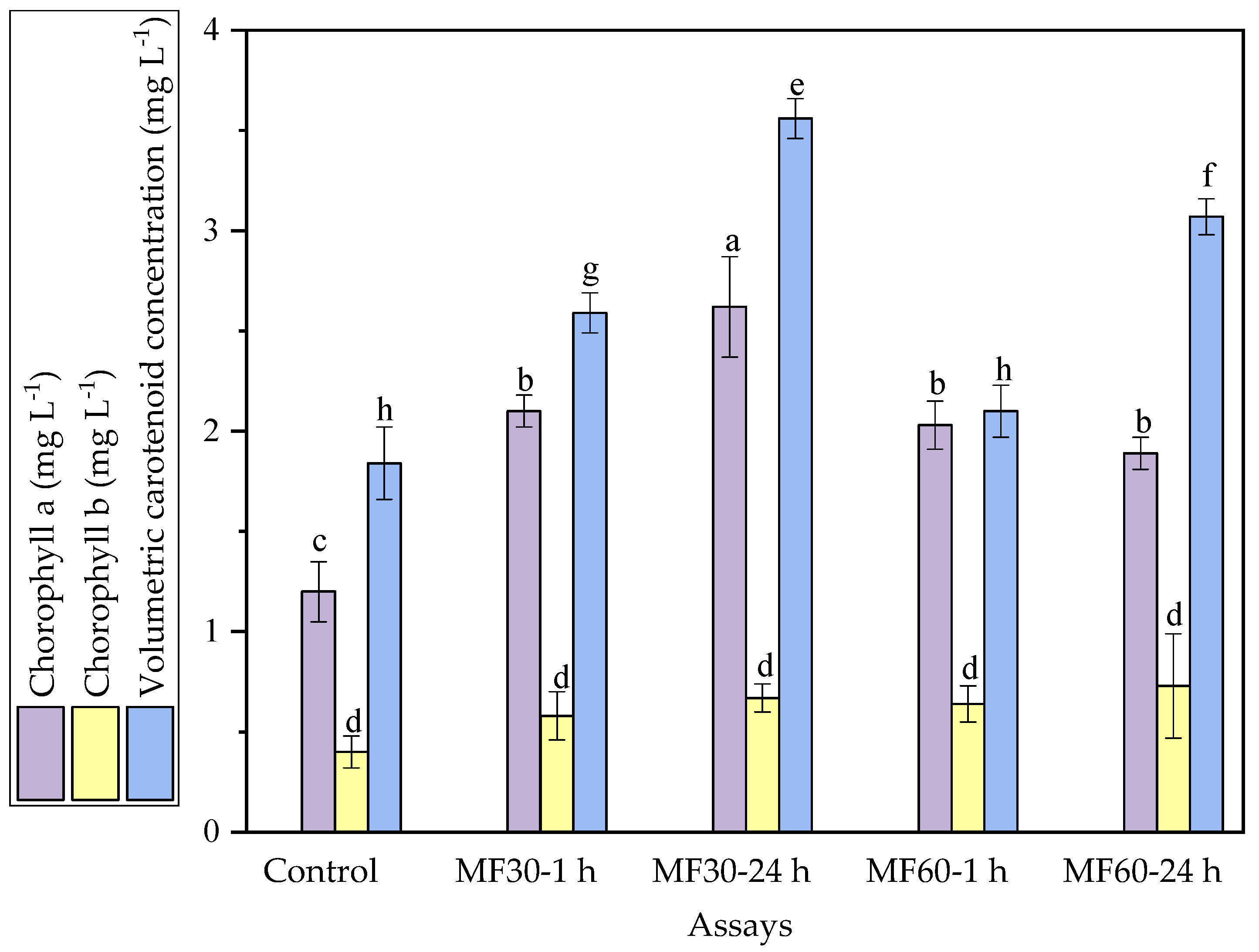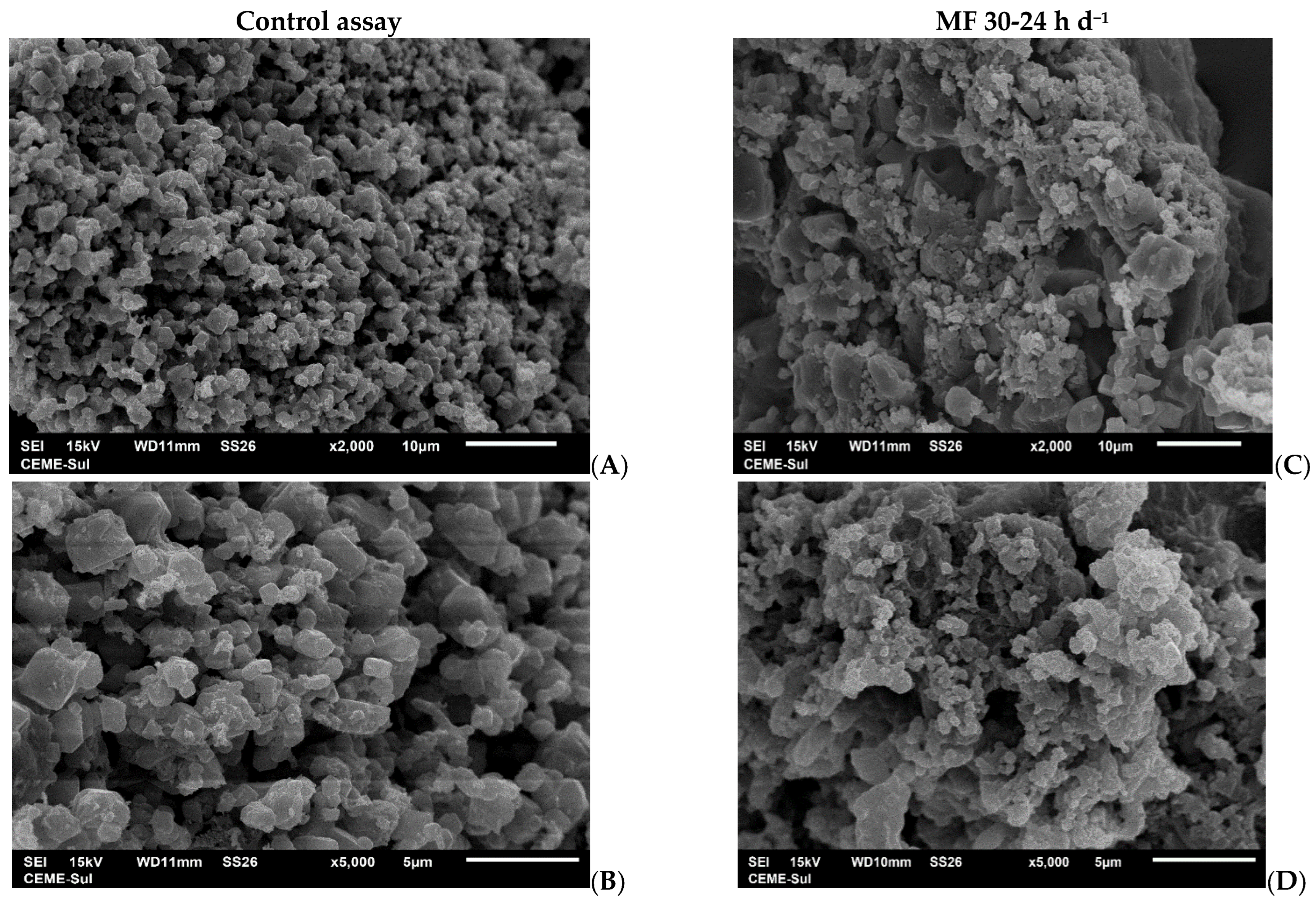Carotenoid Production by Dunaliella salina with Magnetic Field Application
Abstract
1. Introduction
2. Material and Methods
2.1. Maintenance and Inoculum Cultivation of the Microorganism
2.2. Pigment Production with Magnetic Field (MF) Evaluation
2.3. Determination of pH, Biomass and Cell Concentration
2.4. Extraction and Determination of Carotenoid, Chlorophyll-a and Chlorophyll-b Concentrations
2.5. Biochemical Composition of Biomass
2.6. Scanning Electron Microscopy (SEM)
2.7. Statistical Analysis
3. Results and Discussion
3.1. Effects of Magnetic Field (MF) on Cell Concentration, Biomass and pH
3.2. Influence of Magnetic Field (MF) on Pigment Production
3.3. Influence of Magnetic Field (MF) on Biochemical Composition
3.4. Evaluation of Microalga Cell Morphology by Scanning Electron Microscopy (SEM)
3.5. D. salina Exposed to Magnetic Field (MF): Applications of Biomass and Associated Technological Challenges
4. Conclusions
Author Contributions
Funding
Institutional Review Board Statement
Informed Consent Statement
Data Availability Statement
Acknowledgments
Conflicts of Interest
References
- Stachowiak, B.; Szulc, P. Astaxanthin for the Food Industry. Molecules 2021, 26, 2666. [Google Scholar] [CrossRef]
- Razzak, S.A. Comprehensive overview of microalgae—Derived carotenoids and their applications in diverse industries. Algal Res. 2024, 78, 103422. [Google Scholar] [CrossRef]
- Sirohi, P.; Verma, H.; Singh, S.K.; Singh, V.K.; Pandey, J.; Khusharia, S.; Kumar, D.; Kaushalendra; Teotia, P.; Kumar, A. Microalgal carotenoids: Therapeutic application and latest approaches to enhance the production. Curr. Issues Mol. Biol. 2022, 44, 6257–6279. [Google Scholar] [CrossRef] [PubMed]
- Yang, W.; Cao, Y.; Sun, X.; Huang, F.; He, Q.; Qiao, D.; Bai, L. Isolation of a FAD-GPDH gene encoding a mitochondrial FAD--dependent glycerol-3-phosphate dehydrogenase from Dunaliella salina. J. Basic. Microbiol. 2007, 47, 266–274. [Google Scholar] [CrossRef]
- El-Baz, H.H.A.A.; El-Baroty, F.K.E.; El-Baz, G.S. Production of lipids rich in omega 3 fatty acids from the halotolerant alga Dunaliella salina. Biotechnology 2003, 3, 102–108. [Google Scholar] [CrossRef]
- Sui, Y.; Muys, M.; Vermeir, P.; D’Adamo, S.; Vlaeminck, S.E. Light regime and growth phase affect the microalgal production of protein quantity and quality with Dunaliella salina. Bioresour. Technol. 2019, 275, 145–152. [Google Scholar] [CrossRef]
- Freitas, B.C.B.; Brächer, E.H.; de Morais, E.G.; Atala, D.I.P.; de Morais, M.G.; Costa, J.A.V. Cultivation of different microalgae with pentose as carbon source and the effects on the carbohydrate content. Environ. Technol. 2019, 40, 1062–1070. [Google Scholar] [CrossRef]
- Ambati, R.R.; Gogisetty, D.; Aswathanarayana, R.G.; Ravi, S.; Bikkina, P.N.; Lei, B.; Su, Y. Industrial potential of carotenoid pigments from microalgae: Current trends and future prospects. Crit. Rev. Food Sci. Nutr. 2019, 59, 1880–1902. [Google Scholar] [CrossRef]
- Pagels, F.; Pereira, R.N.; Vicente, A.A.; Guedes, A.C. Extraction of pigments from microalgae and cyanobacteria—A review on current methodologies. Appl. Sci. 2021, 11, 5187. [Google Scholar] [CrossRef]
- Patel, A.; Gami, B.; Patel, P.; Patel, B. Biodiesel production from microalgae Dunaliella tertiolecta: A study on economic feasibility on large-scale cultivation systems. Biomass. Convers. Biorefin. 2023, 13, 1071–1085. [Google Scholar] [CrossRef]
- Ramos, A.; Coesel, S.; Marques, A.; Rodrigues, M.; Baumgartner, A.; Noronha, J.; Rauter, A.; Brenig, B.; Varela, J. Isolation and characterization of a Stress—Inducible Dunaliella salina Lcy-β Gene encoding a functional lycopene β-cyclase. Appl. Microbiol. Biotechnol. 2008, 79, 819–828. [Google Scholar] [CrossRef]
- Rabbani, S.; Beyer, P.; Lintig, J.V.; Hugueney, P.; Kleinig, H. Induced β-carotene synthesis driven by triacylglycerol deposition in the unicellular alga Dunaliella bardawil. Plant Physiol. 1998, 116, 1239–1248. [Google Scholar] [CrossRef]
- Sánchez-Estudillo, L.; Freile-Pelegrin, Y.; Rivera-Madrid, R.; Robledo, D.; Narváez-Zapata, J.A. regulation of two photosynthetic pigment-related genes during stress-induced pigment formation in the green alga, Dunaliella salina. Biotechnol. Lett. 2006, 28, 787–791. [Google Scholar] [CrossRef] [PubMed]
- Lamers, P.P.; Janssen, M.; De Vos, R.C.H.; Bino, R.J.; Wijffels, R.H. Exploring and exploiting carotenoid accumulation in Dunaliella salina for cell-factory applications. Trends Biotechnol. 2008, 26, 631–638. [Google Scholar] [CrossRef] [PubMed]
- Pirwitz, K.; Rihko-Struckmann, L.; Sundmacher, K. Comparison of flocculation methods for harvesting Dunaliella. Bioresour. Technol. 2015, 196, 145–152. [Google Scholar] [CrossRef] [PubMed]
- Sun, H.; Wang, Y.; He, Y.; Liu, B.; Mou, H.; Chen, F.; Yang, S. Microalgae—Derived pigments for the food industry. Mar. Drugs 2023, 21, 82. [Google Scholar] [CrossRef]
- Celente, G.d.S.; Rizzetti, T.M.; Sui, Y.; Schneider, R.d.C.d.S. Potential use of microalga Dunaliella salina for bioproducts with industrial relevance. Biomass Bioenergy 2022, 167, 106647. [Google Scholar] [CrossRef]
- Zhuang, D.; He, N.; Khoo, K.S.; Ng, E.-P.; Chew, K.W.; Ling, T.C. Application progress of bioactive compounds in microalgae on pharmaceutical and cosmetics. Chemosphere 2022, 291, 132932. [Google Scholar] [CrossRef]
- Patel, A.; Rova, U.; Christakopoulos, P.; Matsakas, L. Microalgal lutein biosynthesis: Recent trends and challenges to enhance the lutein content in microalgal cell factories. Front. Mar. Sci. 2022, 9, 2022. [Google Scholar] [CrossRef]
- Cardoso, L.A.C.; Karp, S.G.; Vendruscolo, F.; Kanno, K.Y.F.; Zoz, L.I.C.; Carvalho, J.C. Biotechnological Production of Carotenoids and Their Applications in Food and Pharmaceutical Products. In Carotenoids; Cvetković, D.J., Nikolic, G.S., Eds.; IntechOpen: Rijeka, Croatia, 2017. [Google Scholar] [CrossRef]
- Havas, F.; Krispin, S.; Cohen, M.; Loing, E.; Farge, M.; Suere, T.; Attia-Vigneau, J. A Dunaliella salina extract counteracts skin aging under intense solar irradiation thanks to its antiglycation and anti-inflammatory properties. Mar. Drugs 2022, 20, 104. [Google Scholar] [CrossRef]
- Chen, L.; Zhang, K.; Wang, M.; Zhang, Z.; Feng, Y. Enhancement of magnetic field on fermentative hydrogen production by Clostridium pasteurianum. Bioresour. Technol. 2021, 341, 125764. [Google Scholar] [CrossRef] [PubMed]
- Cardoso, A.C.S.; Azevedo, R.S.; Santos, L.O.; Marins, L.F. Combined effect of light and magnetic field on recombinant protein production driven by photosystem ii-related gene promoters in the cyanobacterium Synechococcus elongatus PCC 7942. J. Appl. Phycol. 2025, 37, 811–821. [Google Scholar] [CrossRef]
- Li, J.; Li, D.; Liang, D.; Wu, Y.; Zhu, Y.; Du, L.; Yin, M.; Geng, Y.; Wu, Y.; Li, J. Static magnetic fields enhance microbial aggregation and adhesion to promote aerobic granulation. Chem. Eng. J. 2024, 489, 151392. [Google Scholar] [CrossRef]
- Albuquerque, W.W.C.; Costa, R.M.P.B.; Fernandes, T.d.S.E.; Porto, A.L.F. Evidences of the static magnetic field influence on cellular systems. Prog. Biophys. Mol. Biol. 2016, 121, 16–28. [Google Scholar] [CrossRef]
- Zhang, X.; Yarema, K.; Xu, A. Impact of Static Magnetic Field (SMF) on Microorganisms, Plants and Animals. In Biological Effects of Static Magnetic Fields; Springer: Singapore, 2017; pp. 133–172. [Google Scholar] [CrossRef]
- Khorshidi, N.; Hassanpour, H.; Ziyadi, H. Static magnetic field improved growth and astaxanthin production in Haematococcus lacustris via the regulation of carbohydrate accumulation, H2O2 Level, and antioxidant defense system. J. Appl. Phycol. 2022, 34, 2283–2295. [Google Scholar] [CrossRef]
- Bauer, L.M.; Costa, J.A.V.; da Rosa, A.P.C.; Santos, L.O. Growth stimulation and synthesis of lipids, pigments and antioxidants with magnetic fields in Chlorella kessleri cultivations. Bioresour. Technol. 2017, 244, 1425–1432. [Google Scholar] [CrossRef]
- Deamici, K.M.; de Morais, M.G.; Dos Santos, L.O.; Gros, F.; Costa, J.A.V.; Laroche, C. Magnetic field action on Limnospira indica PCC8005 cultures: Enhancement of biomass yield and protein content. Appl. Sci. 2022, 12, 1533. [Google Scholar] [CrossRef]
- Costa, S.S.; Peres, B.P.; Machado, B.R.; Costa, J.A.V.; Santos, L.O. Increased lipid synthesis in the culture of Chlorella homosphaera with magnetic fields application. Bioresour. Technol. 2020, 315, 123880. [Google Scholar] [CrossRef]
- Menestrino, B.; Sala, L.; Costa, J.A.V.; Buffon, J.G.; Santos, L.O. Magnetic fields exhibit a positive impact on lipid and biomass yield during phototrophic cultivation of Spirulina sp. Bioprocess. Biosyst. Eng. 2021, 44, 2087–2097. [Google Scholar] [CrossRef]
- Hristov, J. Magnetic field assisted fluidization—A unified approach. Part 8. mass transfer: Magnetically assisted bioprocesses. Rev. Chem. Eng. 2010, 26, 55–128. [Google Scholar] [CrossRef]
- Shaish, A.; Ben-Amotz, A.; Avron, M. [41] Biosynthesis of β-carotene in Dunaliella. In Methods in Enzymology; Academic Press: Boston, MA, USA, 1992; Volume 213, pp. 439–444. [Google Scholar] [CrossRef]
- Official Methods of AnalysisTM, 22st Edition (2023)—AOAC INTERNATIONAL. Available online: https://www.aoac.org/official-methods-of-analysis/?gad_source=1&gad_campaignid=21033108646&gbraid=0AAAAA9SMn_VlLMiIXwXEZOeQz0vLUBqKA&gclid=Cj0KCQjwh5vFBhCyARIsAHBx2wzOaPQ-RmW5zUGecvN1igmB0ps2GCTYFYbtwlrUer6qpmMyPwJbISsaAvW4EALw_wcB (accessed on 18 August 2025).
- Bailey, J.E.; Ollis, D.F.; University, U. of H.P. Biochemical Engineering Fundamentals; McGraw-Hill Inc., US: New York, NY, USA, 1986. [Google Scholar]
- Caspers, H. J. D. H. Strickland and T. R. Parsons: A Practical Handbook of Seawater Analysis. Ottawa: Fisheries Research Board of Canada, Bulletin 167, 1968. 293. Int. Rev. Gesamten Hydrobiol. Hydrogr. 1970, 55, 167. [Google Scholar] [CrossRef]
- Lichtenthaler, H.K. Chlorophylls and Carotenoids: Pigments of Photosynthetic Biomembranes. In Methods in Enzymology; Academic Press: Boston, MA, USA, 1987; pp. 350–382. [Google Scholar] [CrossRef]
- Lowry, O.H.; Rosebrough, N.J.; Farr, A.L.; Randall, R.J. Protein measurement with the folin phenol reagent. J. Biol. Chem. 1951, 193, 265–275. [Google Scholar] [CrossRef] [PubMed]
- DuBois, M.; Gilles, K.A.; Hamilton, J.K.; Rebers, P.A.; Smith, F. Colorimetric method for determination of sugars and related substances. Anal. Chem. 1956, 28, 350–356. [Google Scholar] [CrossRef]
- Marsh, J.B.; Weinstein, D.B. Simple charring method for determination of lipids. J. Lipid Res. 1966, 7, 574–576. [Google Scholar] [CrossRef] [PubMed]
- Xu, Y.; Ibrahim, I.M.; Harvey, P.J. The influence of photoperiod and light intensity on the growth and photosynthesis of Dunaliella salina (chlorophyta) CCAP 19/30. Plant Physiol. Biochem. 2016, 106, 305–315. [Google Scholar] [CrossRef]
- Borovkov, A.B.; Gudvilovich, I.N.; Memetshaeva, O.A.; Avsiyan, A.L.; Lelekov, A.S.; Novikova, T.M. Morphological and morphometrical features in Dunaliella salina (chlamydomonadales, dunaliellaceae) during the two-phase cultivation mode. Ecol. Montenegrina 2019, 22, 157–165. [Google Scholar] [CrossRef]
- Borovkov, A.B.; Gudvilovich, I.N.; Avsiyan, A.L.; Lantushenko, A.O.; Rylkova, O.A.; Memetshaeva, O.A.; Degtyar, I.V.; Chekushkin, A.A. Productivity and morphometric parameters of the microalga Dunaliella salina IBSS-2 under pilot cultivation in continental mid-latitude climate in spring. 3 Biotech 2021, 11, 438. [Google Scholar] [CrossRef]
- Deamici, K.M.; De Morais, M.G.; Santos, L.O.; Muylaert, K.; Gardarin, C.; Costa, J.A.V.; Laroche, C. Static magnetic fields effects on polysaccharides production by different microalgae strains. Appl. Sci. 2021, 11, 5299. [Google Scholar] [CrossRef]
- Li, C.; Hu, Z.; Gao, Y.; Ma, Y.; Pan, X.; Li, X.; Liu, S.; Chu, B. Bioeffects of static magnetic fields on the growth and metabolites of C. pyrenoidosa and T. obliquus. J. Biotechnol. 2022, 351, 1–8. [Google Scholar] [CrossRef]
- Zhang, J.; Huang, B.; Tang, T. Effect of co-culture with Halomonas mongoliensis on Dunaliella salina growth and phenol degradation. Front. Bioeng. Biotechnol. 2022, 10, 1072868. [Google Scholar] [CrossRef]
- Ying, K.; Gilmour, D.J.; Zimmerman, W.B. Effects of CO2 and pH on growth of the microalga Dunaliella salina. J. Microb. Biochem. Technol. 2014, 6, 167–173. [Google Scholar] [CrossRef]
- Huang, B.; Qu, G.; He, Y.; Zhang, J.; Fan, J.; Tang, T. Study on high-CO2 tolerant Dunaliella salina and its mechanism via transcriptomic analysis. Front. Bioeng. Biotechnol. 2022, 10, 1086357. [Google Scholar] [CrossRef] [PubMed]
- Small, D.P.; Hüner, N.P.A.; Wan, W. Effect of static magnetic fields on the growth, photosynthesis and ultrastructure of Chlorella kessleri microalgae. Bioelectromagnetics 2012, 33, 298–308. [Google Scholar] [CrossRef] [PubMed]
- Porra, R.J.; Meisch, H.U. The biosynthesis of chlorophyll. Trends Biochem. Sci. 1984, 9, 99–104. [Google Scholar] [CrossRef]
- Serrano, G.; Miranda-Ostojic, C.; Ferrada, P.; Wulff-Zotelle, C.; Maureira, A.; Fuentealba, E.; Gallardo, K.; Zapata, M.; Rivas, M. Response to static magnetic field-induced stress in Scenedesmus obliquus and Nannochloropsis gaditana. Mar. Drugs 2021, 19, 527. [Google Scholar] [CrossRef]
- Asundi, S.; Rout, S.; Stephen, S.; Khandual, S.; Dutta, S.; Kumar, S. parametric study of the effect of increased magnetic field exposure on microalgae Chlorella vulgaris growth and bioactive compound production. Phycology 2024, 4, 314–329. [Google Scholar] [CrossRef]
- Wu, Z.; Duangmanee, P.; Zhao, P.; Ma, C. the effects of light, temperature, and nutrition on growth and pigment accumulation of three Dunaliella salina strains isolated from saline soil. Jundishapur J. Microbiol. 2016, 9, e26732. [Google Scholar] [CrossRef]
- Geacintov, N.E.; van Nostrand, F.; Pope, M.; Tinkel, J.B. Magnetic field effect on the chlorophyll fluorescence in Chlorella. Biochim. Et Biophys. Acta (BBA)-Bioenerg. 1971, 226, 486–491. [Google Scholar] [CrossRef]
- Chu, F.-J.; Wan, T.-J.; Pai, T.-Y.; Lin, H.-W.; Liu, S.-H.; Huang, C.-F. Use of magnetic fields and nitrate concentration to optimize the growth and lipid yield of Nannochloropsis oculata. J. Environ. Manag. 2020, 253, 109680. [Google Scholar] [CrossRef]
- Hunt, R.; Zavalin, A.; Bhatnagar, A.; Chinnasamy, S.; Das, K. Electromagnetic biostimulation of living cultures for biotechnology, biofuel and bioenergy applications. Int. J. Mol. Sci. 2009, 10, 4515–4558. [Google Scholar] [CrossRef]
- Font, Y.S.; Díaz, Y.O.; Cuypers, A.; Alemán, E.I.; Vandamme, D. The effect of magnetic field treatment on the cultivation of microalgae: An overview of involved mechanisms. J. Appl. Phycol. 2023, 35, 1525–1536. [Google Scholar] [CrossRef]
- Najar-Almanzor, C.E.; Velasco-Iglesias, K.D.; Nunez-Ramos, R.; Uribe-Velázquez, T.; Solis-Bañuelos, M.; Fuentes-Carrasco, O.J.; Chairez, I.; García-Cayuela, T.; Carrillo-Nieves, D. Microalgae-assisted green bioremediation of food-processing wastewater: A sustainable approach toward a circular economy concept. J. Environ. Manag. 2023, 345, 118774. [Google Scholar] [CrossRef]
- Sincak, M.; Luptakova, A.; Matusikova, I.; Jandacka, P.; Sedlakova-Kadukova, J. Application of a magnetic field to enhance the environmental sustainability and efficiency of microbial and plant biotechnological processes. Sustainability 2023, 15, 14459. [Google Scholar] [CrossRef]
- Xu, S.; Jiang, Y.; Liu, Y.; Esakkimuthu, S.; Chen, H.; Wang, S. Impact of constant magnetic field on enhancing the microalgal biomass and biomolecules accumulations and life cycle assessment of the approach. Algal Res. 2024, 80, 103563. [Google Scholar] [CrossRef]
- Castellanos-Huerta, I.; Gómez-Verduzco, G.; Tellez-Isaias, G.; Ayora-Talavera, G.; Bañuelos-Hernández, B.; Petrone-García, V.M.; Fernández-Siurob, I.; Garcia-Casillas, L.A.; Velázquez-Juárez, G. Dunaliella salina as a potential biofactory for antigens and vehicle for mucosal application. Processes 2022, 10, 1776. [Google Scholar] [CrossRef]
- Ashokkumar, V.; Flora, G.; Sevanan, M.; Sripriya, R.; Chen, W.H.; Park, J.-H.; Rajesh Banu, J.; Kumar, G. Technological advances in the production of carotenoids and their applications—A critical review. Bioresour. Technol. 2023, 367, 128215. [Google Scholar] [CrossRef] [PubMed]
- Keramati, A.; Pajoum Shariati, F.; Tavakoli, O.; Akbari, Z.; Rezaei, M. The effect of audible sound frequency on the growth and beta-carotene production of Dunaliella salina. S. Afr. J. Bot. 2021, 141, 373–382. [Google Scholar] [CrossRef]
- Rammuni, M.N.; Ariyadasa, T.U.; Nimarshana, P.H.V.; Attalage, R.A. Comparative assessment on the extraction of carotenoids from microalgal sources: Astaxanthin from H. Pluvialis and β-Carotene from D. salina. Food Chem. 2019, 277, 128–134. [Google Scholar] [CrossRef]
- Visan, S.; Soritau, O.; Tatomir, C.; Baldasici, O.; Balacescu, L.; Balacescu, O.; Muntean, P.; Gherasim, C.; Pintea, A. The bioactive properties of carotenoids from lipophilic sea buckthorn extract (Hippophae rhamnoides L.) in Breast Cancer Cell Lines. Molecules 2023, 28, 4486. [Google Scholar] [CrossRef]
- Abe, K.; Nishimura, N.; Hirano, M. Simultaneous production of β-carotene, vitamin E and vitamin C by the aerial microalga Trentepohlia aurea. J. Appl. Phycol. 1999, 11, 331–336. [Google Scholar] [CrossRef]
- Jafari, S.; Mobasher, M.A.; Najafipour, S.; Ghasemi, Y.; Mohkam, M.; Ebrahimi, M.A.; Mobasher, N. Antibacterial potential of Chlorella vulgaris and Dunaliella salina extracts against Streptococcus mutans. Jundishapur J. Nat. Pharm. Prod. 2018, 13, e13226. [Google Scholar] [CrossRef]
- Darvish, M.; Jalili, H.; Ranaei-Siadat, S.-O.; Sedighi, M. Potential cytotoxic effects of peptide fractions from Dunaliella salina protein hydrolyzed by gastric proteases. J. Aquat. Food Prod. Technol. 2018, 27, 165–175. [Google Scholar] [CrossRef]
- El Arroussi, H.; Benhima, R.; El Mernissi, N.; Bouhfid, R.; Tilsaghani, C.; Bennis, I.; Wahby, I. Screening of marine microalgae strains from Moroccan coasts for biodiesel production. Renew. Energy 2017, 113, 1515–1522. [Google Scholar] [CrossRef]




| Conditions | Biomass Concentration (g L−1) | Cell Concentration (cells mL−1) |
|---|---|---|
| Control | 0.39 ± 0.02 b | 6.47 × 105 ± 1.92 × 104 b |
| MF30-1 h | 0.50 ± 0.01 ab | 8.21 × 105 ± 2.08 × 104 a |
| MF30-24 h | 0.55 ± 0.01 a | 8.89 × 105 ± 6.99 × 104 a |
| MF60-1 h | 0.43 ± 0.07 b | 8.44 × 105 ± 6.43 × 104 a |
| MF60-24 h | 0.59 ± 0.04 a | 8.69 × 105 ± 1.73 × 104 a |
| Condition | Chlorophyll-a (mg g−1) | Chlorophyll-b (mg g−1) | Carotenoids (mg g−1) |
|---|---|---|---|
| Control | 3.06 ± 0.38 b | 1.01 ± 0.21 a | 4.73 ± 0.48 b |
| MF30-1 h | 4.19 ± 0.17 a | 1.16 ± 0.25 a | 5.18 ± 0.21 b |
| MF30-24 h | 4.77 ± 0.46 a | 1.22 ± 0.13 a | 6.47 ± 0.17 a |
| MF60-1 h | 4.71 ± 0.28 a | 1.50 ± 0.22 a | 4.87 ± 0.30 b |
| MF60-24 h | 3.21 ± 0.01 b | 1.23 ± 0.44 a | 5.21 ± 0.16 b |
| Assay | Carbohydrates (%, w w−1) | Protein (%, w w−1) | Lipids (%, w w−1) |
|---|---|---|---|
| Control | 31.15 ± 0.59 a | 44.12 ± 1.10 a | 15.23 ± 1.01 c |
| MF30-1 h | 23.73 ± 0.98 b | 39.90 ± 2.60 a | 22.19 ± 0.57 a |
| MF30-24 h | 30.92 ± 1.10 a | 43.65 ± 1.99 a | 15.18 ± 0.88 c |
| MF60-1 h | 25.80 ± 0.43 b | 40.93 ± 1.71 a | 18.77 ± 0.53 b |
| MF60-24 h | 29.22 ± 1.04 a | 40.41 ± 1.45 a | 16.86 ± 1.07 c |
Disclaimer/Publisher’s Note: The statements, opinions and data contained in all publications are solely those of the individual author(s) and contributor(s) and not of MDPI and/or the editor(s). MDPI and/or the editor(s) disclaim responsibility for any injury to people or property resulting from any ideas, methods, instructions or products referred to in the content. |
© 2025 by the authors. Licensee MDPI, Basel, Switzerland. This article is an open access article distributed under the terms and conditions of the Creative Commons Attribution (CC BY) license (https://creativecommons.org/licenses/by/4.0/).
Share and Cite
Silva, I.Q.; Machado, B.R.; Ferreira, T.M.; Borges, J.d.F.; Teixeira, C.M.L.L.; Santos, L.O. Carotenoid Production by Dunaliella salina with Magnetic Field Application. Fermentation 2025, 11, 487. https://doi.org/10.3390/fermentation11080487
Silva IQ, Machado BR, Ferreira TM, Borges JdF, Teixeira CMLL, Santos LO. Carotenoid Production by Dunaliella salina with Magnetic Field Application. Fermentation. 2025; 11(8):487. https://doi.org/10.3390/fermentation11080487
Chicago/Turabian StyleSilva, Izabela Queiroz, Bruno Roswag Machado, Tamires Machado Ferreira, Júlia de Farias Borges, Cláudia Maria Luz Lapa Teixeira, and Lucielen Oliveira Santos. 2025. "Carotenoid Production by Dunaliella salina with Magnetic Field Application" Fermentation 11, no. 8: 487. https://doi.org/10.3390/fermentation11080487
APA StyleSilva, I. Q., Machado, B. R., Ferreira, T. M., Borges, J. d. F., Teixeira, C. M. L. L., & Santos, L. O. (2025). Carotenoid Production by Dunaliella salina with Magnetic Field Application. Fermentation, 11(8), 487. https://doi.org/10.3390/fermentation11080487







